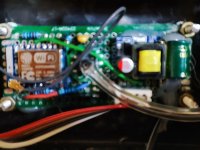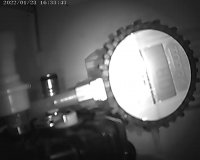dtashmore547
Well-Known Member
- Joined
- Jan 8, 2020
- Messages
- 135
- Reaction score
- 56
this is my first post and I would like to give back a little to this forum for all the help it has given me.
does anyone else have the same problem as I had? having gone into pressure fermentation and finding it very advantageous I was concerned with monitoring my pressure, my fermentation chamber is in my brew shed at the bottom of the garden and proved awkward for monitoring the pressure from my kegland spunding valve, my solution was to put the information on my wifi via a esp8266 module. if anyone with sufficient soldering and programming (Arduino) skills would like the info please respond via this thread and I can post the details.
components used
I used an esp8266 esp-07 with external antenna plus ceramic antenna
for the distance required but others will suffice as it only requires 1 analog I/p and 1 digital output for a meter (pwm)
1 x 3135 20v digital meter ( changed solder points on back to give 1 decimal place)
1 x XGZP6847200KPG 200 kpg pressure sensor module (29psi)
1 x usb to serial module to program the esp module
1 x 80-250v to 5v 700mA supply
1 x 3cm by 7cm pcb prototype board
2 x project box 7cm W by 13cm L by 4cm H
4 x 10k resistors
1 x 5k6 resistor
1x 1k6 resistor
1x 1k resistor
1 x 4 pin single row 0.1in header to connect with the usb to serial module
2 x 0.1uF ceramic capacitor
so the cost is fairly minimal
does anyone else have the same problem as I had? having gone into pressure fermentation and finding it very advantageous I was concerned with monitoring my pressure, my fermentation chamber is in my brew shed at the bottom of the garden and proved awkward for monitoring the pressure from my kegland spunding valve, my solution was to put the information on my wifi via a esp8266 module. if anyone with sufficient soldering and programming (Arduino) skills would like the info please respond via this thread and I can post the details.
components used
I used an esp8266 esp-07 with external antenna plus ceramic antenna
for the distance required but others will suffice as it only requires 1 analog I/p and 1 digital output for a meter (pwm)
1 x 3135 20v digital meter ( changed solder points on back to give 1 decimal place)
1 x XGZP6847200KPG 200 kpg pressure sensor module (29psi)
1 x usb to serial module to program the esp module
1 x 80-250v to 5v 700mA supply
1 x 3cm by 7cm pcb prototype board
2 x project box 7cm W by 13cm L by 4cm H
4 x 10k resistors
1 x 5k6 resistor
1x 1k6 resistor
1x 1k resistor
1 x 4 pin single row 0.1in header to connect with the usb to serial module
2 x 0.1uF ceramic capacitor
so the cost is fairly minimal














































![Craft A Brew - Safale S-04 Dry Yeast - Fermentis - English Ale Dry Yeast - For English and American Ales and Hard Apple Ciders - Ingredients for Home Brewing - Beer Making Supplies - [1 Pack]](https://m.media-amazon.com/images/I/41fVGNh6JfL._SL500_.jpg)















